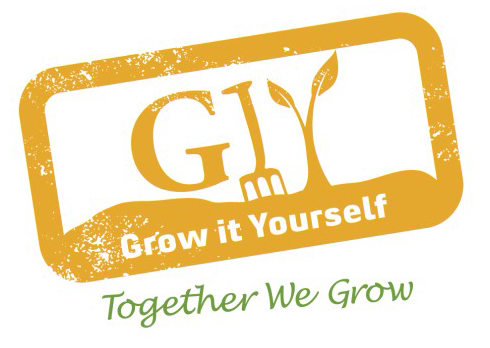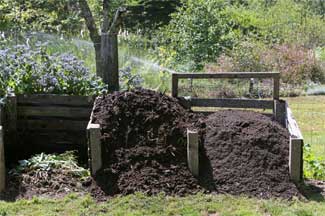Grow it Yourself - October
 Soil. Well, it’s just dirt really, isn’t it? It’s something to be cleaned off our boots and scrubbed off our hands, right? When I started growing my own food, I didn’t have any respect for the soil that the veg was growing in. My focus was on the seed, the plants, the vegetables. The soil was actually a source of annoyance to me - it had to be dug, raked, hoed, rotovated, coaxed and cajoled.
Soil. Well, it’s just dirt really, isn’t it? It’s something to be cleaned off our boots and scrubbed off our hands, right? When I started growing my own food, I didn’t have any respect for the soil that the veg was growing in. My focus was on the seed, the plants, the vegetables. The soil was actually a source of annoyance to me - it had to be dug, raked, hoed, rotovated, coaxed and cajoled.
If we brought in a big digger and scraped the thin little layer (about 6 to 8 inches) of rich topsoil off the surface of our planet, all life as we know it would cease to exist. Plant matter would not grow, and without plant matter there would be no animals (including humans). Given its importance to our survival, it’s strange that we treat it with such contempt. Centuries of commercial agriculture has assumed that we can continue to rob the soil of it’s nutrients by growing intensively from it and that all we need to do is replace the three core nutrients of nitrogen, phosphorus and potassium (the key ingredients of commercial NPK fertilizer).
 In fact, what soil needs to support life is far more complex than that. Composts and manures (which are the organic alternative to chemical fertilizers) also return dozens of trace minerals and other nutrients to the soil – the vegetables that grow in this soil have more nutrients in them as a result and healthier veg leads to healthier people. Then, having served their purpose in the kitchen, the vegetable trimmings and waste are returned to the compost, releasing the nutrients that are left back to the compost heap and then eventually back to the soil. Even a cursory understanding of this never-ending cycle of growth-maturity-decay leads you to one conclusion: growing your own food is actually all about the soil.
In fact, what soil needs to support life is far more complex than that. Composts and manures (which are the organic alternative to chemical fertilizers) also return dozens of trace minerals and other nutrients to the soil – the vegetables that grow in this soil have more nutrients in them as a result and healthier veg leads to healthier people. Then, having served their purpose in the kitchen, the vegetable trimmings and waste are returned to the compost, releasing the nutrients that are left back to the compost heap and then eventually back to the soil. Even a cursory understanding of this never-ending cycle of growth-maturity-decay leads you to one conclusion: growing your own food is actually all about the soil.
From that perspective, my most significant achievement as a GIYer has been to learn how to make proper compost. Each winter I put wheelbarrow loads of the crumbly stuff on my vegetable beds. And each year my soil starts to look less like a potter’s clay, and becomes a little darker, a little more crumbly and a lot more lovable. In a nutshell - I’ve stopped treating my soil like dirt…
The Basics – Pick Blackberries
As autumn progresses and we move in to October, we’re coming to the end of what has been a tremendous blackberry season. Sometimes you’ve got to be impressed with Mother Nature’s infinite wisdom. As we approach winter and the first snivels and colds, what does she do? She piles hedgerows all around us full with more free vitamin C then you could shake a stick at. Blackberries have been consumed by humans for up to 2,500 years, contain polyphenol antioxidants, and are abundant in vitamin C.
It’s pretty ridiculous that we spend good money on fruit/berries and vitamin C tablets while millions of Blackberries rot in ditches all over Ireland. If you spend the time to pick them you can then freeze them and enjoy for months to come. Blackberries are supremely useful – they can go in to jams, smoothies, tarts, wine, tea, ink and dyes. So get picking.
Recipe of the Week – Blackberry and Apple Crumble
Eldest Boy at home here has become somewhat of a whiz at making Blackberry and Apple crumble and he’s at the age now where he can pretty much manage the process from end to end – including picking the blackberries. Happy days.. It’s the ultimate autumn comfort food.
Ingredients:
• 900g apples – peeled, cored and cut in to chunks
• 350g blackberries
• 160g demerara sugar
• Juice of 2 lemons
• 225g plain flour
• 175g butter
• 125g muesli or a mixture of porridge oats, seeds and chopped nuts
Directions:
Preheat the oven to 200C. Pour the lemon juice over the apples - this will add flavour and stops the apples from going brown. Layer the apples, blackberries, and sugar in a lasagne dish. Place the flour in a large bowl and then rub in the butter until it resembles breadcrumbs. Add the muesli and another 50g sugar and mix through. Sprinkle the crumble topping over the fruit. Bake for 45 minutes. Cool for a few minutes and then serve with custard or cream.
About GIY
GIY is a not-for-profit organisation that aims to create a healthier, more sustainable world where people grow their own food. We inspire and support people to grow food more successfully by bringing them together to share advice, tips and ideas. There are approximately 65,000 people involved in the GIY movement in Ireland, which is proudly supported by Woodies DIY.
For more information check out www.giyireland.com
Michael Kelly is a freelance journalist, author and founder of GIY Ireland.
© GIY Ireland 2018 – all rights reserved.





There are currently no comments
Leave a comment
Not a member? Register for your free membership now!
Or leave a comment by logging in with: